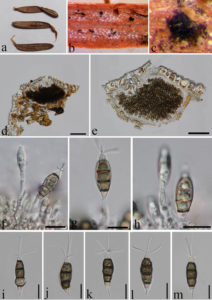Pestalotiopsis sequoiae W.J. Li, Camporesi & K.D. Hyde, in Hyde et al., Fungal Diversity 80: 210 (2016)
Index Fungorum number: IF 552215; MycoBank number: MB 552215; Facesoffungi number: FoF 02352
Etymology – Named after the host genus Sequoia.
Saprobic on dead stem of Sequoia sempervirens (Lamb. ex D. Don) Endl. (Cupressaceae). Sexual morph Undetermined. Asexual morph Coelomycetous. Conidiomata 160–305 μm diam. x 162–326 μm high, black, solitary to aggregated or confluent, subperidermal in origin, erumpent at maturity, pycnidioid, globose to subglobose, unilocular, glabrous, straw-coloured with dark center; wall 10–20 μm wide, composed of thin-walled, hyaline cells of textura angularis to textura globulosa. Conidiophores reduced to conidiogenous cells. Conidiogenous cells 4–24 μm long x 2–4 μm wide, hyaline, enteroblastic, lageniform to subcylindrical, arising from the cells lining the inner wall of the pycnidium. Conidia 21–30 x 7.5–10 μm (x=25 x 8.5 μm, n = 30 μm), fusiform, 4-septate, straight or slightly curved, bearing tubular, unbranched, flexuous appendage at both ends, basal cell 2.9–5.7 μm (x = 4.3 μm) long, hyaline, obconic with a truncate base, 3 median cells, together 14.7–20 μm long (second cell from base 4.1–7 (x = 5.6 μm, third cell 5.4–6.9 μm (x = 6.2 μm), fourth cell 4.6–6.7 μm (x = 5.6 μm), cylindrical, pale brown to brown and concolourous, septa and periclinal wall darker, apical cell 2.9–4.8 lm (x = 4 lm) long, hyaline, conical, with mostly 4 apical appendages, 3–17 μm (x = 11 μm) long, with independent loci of origin along upper half of the apical cell, often forming aggregated crest, basal appendage 4–11 μm (x = 6 μm) long, single, unbranched.
Culture characteristics – Colony on PDA reaching 40–50 mm diam. in 7 days, with circular margin, white and fluffy, dense, aerial mycelium on the surface, reverse similar in colour.
Material examined – ITALY. Province of Forlı`-Cesena [FC]), Castrocaro Terme, on dead stem of Sequoia sempervirens (Cupressaceae), 20 October 2012, Erio Camporesi, IT-832 (MFLU 16-1489, holotype); ex-type living culture, MFLUCC 13-0399, ICMP; IT-832B (HKAS 95026, isotype); living culture, KUMCC 15-0642.
Notes – Phylogenetically, based on megablast search of NCBIs GenBank nucleotide database, the closest hit using ITS sequence is Pestalotiopsis hollandica (GenBank KM199328; Identities = 548/548(100 %); Gaps = 0/548(0 %)), Followed by uncultured fungus clone (Gen-Bank = KP889337; Identities = 549/550(99 %); Gaps =0/550(0 %)), and P. monochaeta (GenBank = KM199327; Identities = 547/547(100 %); Gaps = 0/547(0 %)). Closest hits using the TEF sequence yielded highest similarity to P. hollandica (GenBank = KM199481; Identities = 237/238(99 %); Gaps = 1/238(0 %)), Pestalotiopsis sp. (Gen-Bank = KP781881; Identities = 228/230(99 %); Gaps = 2/230(0 %)), P. verruculosa (GenBank = JX399061; Identities = 233/238(98 %); Gaps = 1/238(0 %)). Morphologically, the conidia of Pestalotiopsis sequoiae is smaller than those of P. hollandica [(25–)25.5–33(–34) x 8.5–10(–10.5) μm ], P. monochaeta [(25–)27–40(–42) x 7–11(–11.5) μm ] and P. verruculosa [(28–35 x 9–11 μm (x̄ = 30:6 x 10:3 μm )]. Based on morphology and phylogeny, Pestalotiopsis sequoiae is introduced as novel species in Pestalotiopsis.
Fig 1. Pestalotiopsis sequoiae (MFLU 16-1489, holotype). a Herbarium specimen. b, c, Appearance of black coniodiomata on the host. d, e Vertical sections of conidiomata. f–h Conidiophores, conidiogenous cells and developing conidia. i–m Conidia. Scale bars d = 100 μm , e = 50 μm , f–h = 10 μm, i–m = 5 μm.

